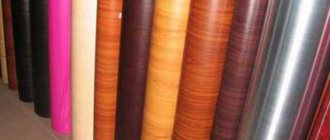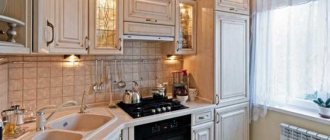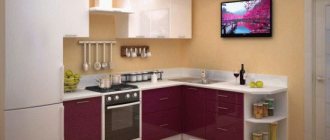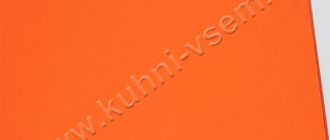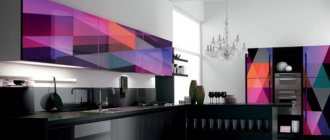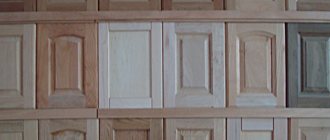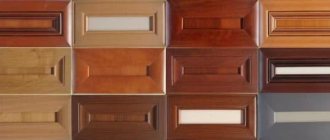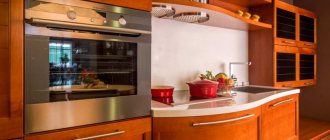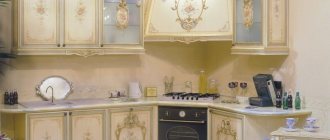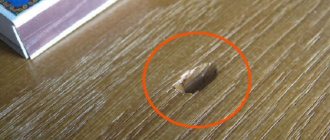Benefits of façade renovation
Self-adhesive film was used to restore the facades. There are times when it begins to come off: if the MDF film has peeled off in the kitchen, you should not rush to replace it with a new one. The film often peels off due to humidity, temperature changes, steam, and the use of low-quality glue.
You should not be surprised if peeling occurs quite quickly, even during loading after manufacture or when the product has a short lifespan. The film peels off from MDF facades for the following reasons:
- The glue is not applied to the entire surface. When the substance is applied manually, the worker often misses sections of the product and the film does not stick to them. You can solve the problem by using colored glue.
- Using a cheap, poor quality substance. Quite often a two-component polyurethane composition is used. It is quite difficult to mix it in the correct proportion, so the glue hardens incorrectly and does not hold well, and bubbles may appear on the film.
- Using expired glue. When using such a material, the film will stick, but will peel off fairly quickly.
- Insufficient temperature during gluing, as a result of which the connection did not go well enough. There can be many reasons: poorly heated film, the vacuum was applied too early, the adhesive layer was thin, the workpieces for the facades were cold, it could have been cold in the workroom, the film was not pressed well enough, due to a weak vacuum supply, the wrong adhesive was chosen, the composition of which does not come into contact with a specific film. The facades themselves could also be used incorrectly: for example, they were located next to heating appliances, a stove, or sources of moisture. Before purchasing, it is important to find out how to properly care for furniture and for what conditions it was made.
How to fix the problem?
If the film on the facade of the MDF kitchen has peeled off , you need to carefully spread it with glue from the edge and press it down. There is a chance that the film will take the desired shape. Another way to restore the coating is to use an adhesive membrane. To do this, you will need to lay the boards on a dry and flat surface, for example, on a table, cover them with a membrane, and use a vacuum. The membrane should tightly cover the facades. If you want greater reliability, you need to use high-quality glue and heat the material so that it can be activated. Warming up should be done evenly. This method is suitable only for unmilled facades: if the surface is uneven, the membrane will not stick and will quickly peel off. Therefore, it is so important to correctly restore kitchen facades while observing certain conditions.
Why is it important to choose the right adhesive?
Most often, films are applied to facades using membrane-vacuum pressing. During this process, glue is first applied to the workpiece and dries, after which the film is applied to the MDF board, heated and pressed. A significant disadvantage of such cladding is the inability to restore it. If “bubbles” have formed during the gluing process, then it will be impossible to correct it. In this regard, it is important to choose a high-quality adhesive for gluing PVC film to wood or MDF.
Using heating devices
If the PVC film peels off from MDF kitchen facades, you can try replacing it with a new film or gluing the old material in place using available electrical appliances. This could be an iron, a powerful home or construction hair dryer. The film needs to be carefully warmed up: it should become quite soft and blurry, but not start to melt. If you have something to try, use these pieces or on an inconspicuous place on the façade. The device is pressed against the edge that is not glued for a few seconds. The film should stretch, the glue should warm up at this moment, and the material should protrude towards the back side of the facade and adhere firmly. If this can be done, then it will be possible to glue the entire facade in this way, in places where the film has retreated.
Advice: the film itself cannot be heated with a hairdryer at close range, as this will curl it and be damaged.
This DIY restoration of kitchen facades requires some skill, but is quite simple to perform and does not require the use of expensive tools or materials. If the inside and corners are poorly glued, you can use a metal rod comparable in size to the frame. First you need to warm it up. For this, you can use, for example, a gas burner.
Restoring coating using friction
Restoring kitchen facades from MDF using this method does not require any available tools at all. In order to glue the separated section of the film, you need to cover it with a rag and start rubbing it with your fingers, pressing the film. If there is adhesive underneath, the temperature from friction in a small area will be enough to activate a chemical reaction and cause the film to stick.
Advice: this method should be used carefully, as there is a high risk of damaging the film, exposing its edge or removing the top layer, which will ruin the appearance of the coating.
Application of glue
Restoring a glossy kitchen can cause some difficulties, since gloss does not tolerate strong physical impact, which is why it should not be roughly rubbed with your fingers or heated closely with any appliances. You can try a safer method - gluing the separated film using “Moment”. Most often, such a film peels off in the kitchen, since it is not affected by hot steam. It is necessary to restore the coating as quickly as possible, otherwise the furniture itself will be damaged. The glue must be applied to the untreated area of the facade and to the film itself along the edge so that it can isolate the seam from negative influences. All this must be done carefully, as the glue easily sticks and gets dirty.
Conclusion: inexpensive do-it-yourself kitchen restoration is quite accessible; it is advisable to look at photos of the finished results in advance. With a careful and competent approach, you can easily restore the appearance of the kitchen without resorting to replacing parts and without spending money and completely replace the facades.
Source: obzorkuhni.ru
How to correctly change facades in the kitchen - choice of material, color, and their installation
The kitchen is the face of the house, so it should be decorated in the same style and be clean and tidy. Over time, it is necessary to replace kitchen facades, since under the influence of external factors (water, grease, steam), the appearance of the set may lose its visual appeal. A preliminary inspection of the furniture frame is required.
If it is in good condition and does not require replacement, you can replace the facades with new options. The whole process consists of several stages:
- Material selection;
- Carrying out work;
- Aftercare for new furniture.
Material selection
Changing the facades in the kitchen is quite simple; today, construction and specialized stores offer various types of materials, which gives you the opportunity to choose. There are several options that have their own advantages and differ in cost.
If we take a product made from chipboard as an example, the main advantage here is the cost. This material is considered the most budget-friendly, but also quite capricious. However, chipboard is a resistant material to external influences and can last up to ten years. The main thing when choosing is to pay attention to product certificates.
Kitchen facades made of MDF also have a fairly long service life, approximately seven years. This is an artificial material, the cost of which is lower than natural wood. The kitchen facades are made of exactly this material and decorate the furniture. It can be matched with photo printing or other effects that decorate the exterior design of the room.
The glossy surface looks great. The advantage of the material is its reliability, it fastens well and is resistant to influences: temperature changes, room humidity, and mechanical damage. It is easy to care for, the surface does not accumulate bacteria.
Glass kitchen facades look quite original. Classic versions of the set are often decorated with original glass, while choosing a thematic design or an abstract pattern.
And classic and modern Scandinavian-style kitchens are decorated with transparent or semi-opaque glass. It can be of different colors, smooth or corrugated. A distinctive feature of this façade is its incredible resistance to dirt and chemicals.
Glass requires safe handling, so for apartments where small children live it is better to choose an alternative option - plexiglass. It weighs little and has a high level of resistance to mechanical stress.
You can be proud of solid wood facades; they look noble and stylish. For a budget option, you can choose an alternative option - this is a veneered structure, which in terms of external characteristics differs little from solid wood.
Source: kuhnier.ru
Materials
Several types of facades meet the above requirements, and the choice in most cases will depend on the financial capabilities and tastes of the person. But when choosing, you should not proceed solely from considerations of economy, purchasing budget options, since cheap and low-quality options will soon have to be changed again.
One of the most expensive is wooden, but it is advisable to use such a material for replacement only if you also had wooden facades before and for some reason they no longer suit you.
Wooden facades must be restored carefully.
But since this material is wear-resistant and can last quite a long time, doubts arise about the need to replace old facades with new ones (in addition, often even damaged facades can be restored). It makes sense to replace another type of facade with wood, and this can be justified by the fact that you decided to give your nondescript set a rich look, corresponding to a new expensive renovation. Another option is painted MDF facades: they are quite durable, look bright and unusual and can adequately withstand all the loads possible in the kitchen. This is a good choice if you decide to update your kitchen design: due to the large selection of colors, MDF facades are easy to choose for any countertop and for any interior.
The undoubted advantage of MDF is that it does not absorb moisture and odor, unlike chipboard cabinets, which means you can safely wash them and not be afraid that the kitchen will constantly smell of burnt fat or fish (which are not actually hanging in air, but are actually absorbed into furniture and curtains).
Such facades have few disadvantages:
- Impacts on such facades leave dents and chips;
- The cost of painted MDF facades is higher than if they were covered with PVC film;
MDF in film looks a little more “modest” than painted facades, but for some people such moderate tones will be just to their liking.
Over time, the coating fades when exposed to direct sunlight in a kitchen located on the sunny side.
Modern production technologies make it possible to quickly produce different sizes according to individual orders, but if previously you had to pay extra for this, now the production of non-standard MDF facades is carried out without increasing the cost. PVC film is resistant to most detergents, but like enamel, the film will fade in the sun.
When ordering facades in PVC film, it is recommended to immediately inspect each facade from the back side: at the junction with the compensation plastic (especially at the corners), small gaps may remain or the film may peel off slightly. Under the influence of high temperatures or steam from cooking food, this film will continue to peel off, but unlike melamine edges, it will not be possible to glue PVC with an iron. Make sure it hangs away from the burners or hob.
Plastic (postforming) is the most common type of kitchen facades, since in terms of price and quality such products are the “golden mean”. Their advantages are obvious:
- Resistant to temperature changes and exposure to sunlight;
- Strength and durability;
- Ability to withstand cleaning using aggressive detergents (except for those containing abrasive particles).
Separately, it is worth mentioning the frame facades. This is a frame made of aluminum or MDF frames with sawn grooves into which you can insert any material of appropriate thickness - from glass to plywood.
There are three main advantages of such facades:
- They are very inexpensive.
- You can insert any material at your discretion into such a frame.
- It is easy to assemble such a structure yourself if you have a drill, a screwdriver and a square to maintain angles of 90 degrees.
Usually, glass is inserted into such facades, but in this case, in the average kitchen there are no more than two or four of them, since not everyone wants guests to see through these glasses not only beautiful dishes for celebrations, but also nondescript pots. If you use opaque materials, this option is acceptable.
How to choose materials for facades:
How to change the facades on a kitchen set with your own hands?
The kitchen is not only the housewife’s workroom, but also a gathering place for the whole family. Therefore, this room should not only be comfortable and functional, but also bring beauty, coziness and comfort to others. The main detail of the furniture is its facade, which catches the eye first, therefore, its appearance must be at the highest level.
Replacing the kitchen façade is an affordable way to change the interior
Replacement of furniture facades can be done for several reasons. This could be a kitchen renovation with a change in interior design, wear and tear of materials, or the usual desire to refresh the decor in the apartment. Updating kitchen facades can be done in several ways. In order to determine the appropriate method, you need to approach the assessment of each situation individually, based on many factors.
Do-it-yourself finishing of kitchen facades with rattan for a country-style kitchen
Do-it-yourself replacement of kitchen facades
Restoring kitchen facades is not difficult
New facades may not necessarily be made in the same style as the previous doors of the set. When replacing facades, the customer can completely change the concept. For example, having made a renovation and changed the overall color scheme of the interior, even the design of a small kitchen, a person wants to change the classic “wood” facades to high-tech facades, while some “solid” facades are supposed to be replaced with doors with glass through which one can see some souvenirs or just a new beautiful set.
Replacing facades can really both refresh the design and make it relevant in a new interior. The only thing left to do is choose the material, color and take measurements. Currently, you can order facades in a variety of colors and from any variety of materials offered by manufacturers.
But not all furniture facades are intended for use in the kitchen, and in order to use them in such a room, the facades must meet the following requirements:
- Some cabinets in the kitchen are opened more often than others, and some of the facades are opened several times a day. This means that the facades should not sag, and the hinges should have an increased working life.
- Facades must be moisture resistant, and their care must include the ability to wipe them with a damp cloth.
- The facades of the modules that are located in close proximity to the stove and oven must withstand high temperatures.
- Ability to withstand mechanical damage.
Video: how to replace the facade film on cabinet doors
How to make furniture facades:
Choosing a design and restoration method
Option for transforming the kitchen after replacing the facades and apron in the kitchen
Replacing the entire kitchen unit is a very expensive undertaking, so restoring kitchen facades looks like a rational move, provided that the rest of the furniture is in good working order. There are three main options for replacing facades: covering with film, painting and replacing the facade slab.
Polyvinyl chloride film (PVC) is mainly used, which is the simplest way to restore furniture facades. The advantages of PVC film are an affordable price, ease of gluing and further operation, high resistance to changes in temperature and humidity (which is very important for a kitchen), a wide range of colors and patterns (the option of selecting a pattern for new facades for any kitchen design, from plain to imitation marble or wood).
One of the easiest ways to update a kitchen set is to stick film on the facades
The option of replacing kitchen facades is more expensive than film, but in this case the client receives a completely new set, with the exception of its frame (as practice shows, it practically does not wear out during normal use). The cost of such restoration depends on the type of material used. The following materials are most often used for this technology.
- Chipboard or fibreboard. Wood panels have a number of advantages, the main one being price. High-quality products made from these materials have good resistance to moisture and temperature changes. The plates can be covered with film, paint or enamel. The most expensive option is to cover it with a layer of wood, which creates the illusion of a wooden product while being affordable.
Due to the shine of laminated chipboard, the kitchen will visually appear larger
Solid wood facades are an expensive, but high-quality and durable option
Metal facades for kitchens in high-tech style
Replacing kitchen facades with modern plastic is an excellent solution; this wear-resistant material remains in its original form for a long time
Glass facades for the kitchen - a combination of external fragility with reliability
Kitchen facade made of artificial stone
Kitchen with MDF fronts covered with veneer
If the structure of the furniture material is in normal condition, and only the appearance needs to be changed, painting is an excellent option. Here everything is limited only by the imagination and financial capabilities of the master, since there are a lot of options with the type of paint and the possibilities of its application on the modern market.
Updating an old but strong wooden set by painting and replacing the countertop
To completely update the appearance of the facades, it is advisable to replace all furniture fittings, matching them to the updated style of the kitchen. With new handles and hinges the set will look much better.
A set with bright colors will look good in spacious rooms
Replacing film on kitchen facades
High-quality kitchen furniture is not cheap, and besides, owners tend to get used to a comfortable set, so even when the facades lose their former appearance, many refuse to replace the cabinets. But numerous visual defects that inevitably appear over years of intensive use make thrifty kitchen owners wonder: is it possible to replace PVC film on MDF facades? In their opinion, if we are not talking about a complete replacement of furniture or at least changing the facades, it will be possible to refresh the set with “little expense.” Some try to act independently and cover the facades over the existing PVC coating with self-adhesive film, which, of course, cannot be a full-fledged finish - both visually and in terms of quality. Yes, this helps to save money, but such steps are only advisable if these are temporary measures and you need to somehow hold out for real repairs.
On online forums you can also find numerous questions about the possibility of replacing the coating of MDF film facades, which at home looks different than under store lighting and is not liked by the owners. So, let's figure it out.
Is it possible to replace PVC film on MDF facades?
Re-coating the facade with MDF film without removing the previous layer is impossible - this will only spoil the material, and the facades will hardly look the way the customer imagines. A self-respecting manufacturer will not undertake such an operation, as he will understand its consequences. But is it possible to get rid of the old coating and apply a new one?
Let us remind you that an MDF panel with a PVC film coating is obtained as a result of exposure to pressure and high temperature. Technically, it is possible to remove the film, however, you need to weigh everything to understand how advisable it is. It is worth taking into account that when the PVC layer is removed, the top layer of the MDF board is also damaged, which means that without treating the base, re-coating is impossible - “craters” will remain on the surface. Of course, you can sand the slab, getting rid of unevenness, but the question arises: how much will it cost, and wouldn’t it be cheaper to order the facades “from scratch” - with the coating you like?
How much does it cost to replace PVC film on MDF facades?
If the customer still insists on reapplying PVC film to old facades with a similar coating, he must be prepared for the fact that there will be no savings. The process of preparing facades for re-processing, an operation that is non-standard for kitchen furniture manufacturers, and consumables will cost him approximately the same amount as the production of new facades. In addition, the option of re-coating old facades is associated with certain household inconveniences: the owner will need to dismantle them, take care of delivery to production, then wait for 10-14 days until the order is completed, and then bring them back. All this time he will be forced to “admire” kitchen cabinets without fronts. When replacing them, the customer can safely continue to use the old set until new facades are manufactured.
Replacement of kitchen facades in St. Petersburg
offers a service for replacing the fronts of kitchen and any other cabinets. This is a great way to freshen up your furniture without overpaying. In addition, if only one or two facades have become unusable, you can replace only them - we will select a PVC coating option for MDF facades that matches the color! Our specialists will take the necessary measurements, produce the necessary parts on time and install new facades, and you will receive an updated kitchen without any extra hassle or expense!
Price for renovation of kitchen facades
| Service | Unit | Price |
| Removing old material | 1 m2 | 450 rub. |
| Primer (single layer) | 1 m2 | 950 rub. |
| Enamel coating | 1 m2 | RUB 1,350 |
| Applying varnish | 1 m2 | 1,150 rub. |
| Stain coating | 1 m2 | 1,250 rub. |
| Adding Patina Details | 1 m2 | 1,700 rub. |
Standard problems and solutions
A kitchen set consists of many individual elements: boxes, drawers, countertops, upper and lower storage sections. They wear out unevenly. Cracks, scratches, and burnt spots appear on horizontal surfaces. The outer coating on the doors peels off and the fastening hinges fail.
Replacing the entire headset is a significant expense. The best solution is to repair kitchen furniture facades by our company’s specialists. An on-site technician will inspect the set and determine which elements and parts need to be modernized.
The most common types of repairs:
- countertop repair. If burnt spots appear on it, or the surface is “swollen” from constant contact with water, it can be replaced with a new one. The material, shape are selected, a bar counter is added, etc.;
- replacement of kitchen facades. If the box is made of high-quality material, repairs only concern the facades. They can be replaced completely, covered with PVC film, and the ends treated. Doors are made of veneer, MDF, chipboard, combined (aluminum with plastic, glass, wood).
There are often situations when the set is well preserved and does not require drastic changes or repairs. But it does not correspond to the overall style of the kitchen and is morally outdated. If so, you can change the color, add photo printing or an aging effect (patina). Decorative elements will also not be superfluous: cornices, arches, columns. The shape of the doors changes using milling, inserting plexiglass additions, and companion materials.
What do we offer
If you need to repair the facade of a kitchen unit, we are ready to perform:
- decoration. It is used if there are minor scratches, cracks, or chips on the working surfaces. They are filled with wax. The next stage is grinding;
- pasting with PVC film. It is carried out if the customer wants to completely renovate the interior, or the area of damage is significant. Decorating alone may not be enough. Depending on the shape of the façade, lamination, laminating or post-forming is used. The film is glued to surfaces or imprinted using special presses;
- painting with enamel, car sprays, acrylic paints, followed by varnishing if necessary. The glisal technique is used. With its help, you can get spectacular color shifts and completely change the appearance of the headset without significant alterations.
We change the content in frame facades. We have rattan, chipboard, plexiglass, and plastic at our disposal. To enhance the effect, we use silk-screen printing, embossing, patination, etc. Do you want to get a kitchen in Provence, ethno, classic style? We will help you!
How cooperation is built
Are you interested in manufacturing or repairing custom kitchen facades? Fill out the feedback form on the website or call the indicated phone numbers. Further:
- A surveyor will come to you at the agreed time. Its task is to assess the condition of the headset, determine the prospects for repair or replacement of individual elements;
- The company’s designers develop layouts with the selection of materials and cost estimates;
- Once the details are agreed upon with the client, the order is submitted for execution. If necessary, the production workshop produces new doors, handles, fittings, and design details;
- The kitchen façade is being repaired directly on site.
Upon completion of the work, a transfer and acceptance certificate is signed. Guarantee provided. The customer makes the payment in any way convenient for him.
Do not try to restore the facade with your own hands if you do not have sufficient experience and carpentry equipment. Contact our company. We guarantee the execution of the most complex order in the shortest possible time!
Source: remont-kuhni.com
A simple way to restore furniture facades from MDF
Hello, dear readers and DIYers!
As you all know very well, almost all modern furniture is made from sheet composite materials.
Most often, the body of a cabinet or hanging cabinet is made of laminated chipboard, and the facades and countertops are made of MDF. MDF lends itself perfectly to milling and other types of processing. As a finishing coating for facades, either paint or PVC plastic film is used. Using film, you can create an imitation of the texture of wood, stone, etc. However, the use of such facades (covered with film) in very harsh kitchen conditions often leads to peeling and cracking of the coating. At the same time, the shape of the facades does not change.
In this article, the author of the YouTube channel “Vladimir Natynchik” will tell you how you can restore kitchen facades from MDF.
The proposed method is very simple, and almost anyone can handle it.
Materials. — Automotive putty — Acrylic enamel, varnish — Turpentine, acetone, or gasoline — Plastic film, masking tape — Sandpaper.
Tools used by the author. — Spray gun — Screwdriver, bits. Manufacturing process. So, Vladimir’s kitchen facades gradually fell into disrepair, and the PVC film began to peel off.
On upper cabinets it can be removed almost effortlessly. The MDF facades themselves were not damaged and did not swell.
First of all, the master unscrews the handle from the door of the lower tier.
Then he rips off the film. It can be removed just as easily as on the upper doors.
After unscrewing the screws that secure the furniture hinges, he removes the doors. The drawer fronts are also dismantled. It is very important to number them, put marks on the doors where each one stood. Otherwise, putting it back together will be another task. Even a simple change of drawers (identical at first glance) will, with a high degree of probability, lead to the fact that they will not close.
So, Vladimir removed all the facades and cleared them of film. Now you can go with them to the workshop.
If chips or dents are found on the surface of the MDF, they can be easily eliminated using automotive putty, which is what the author did. After the putty has dried, the surface is sanded with sandpaper.
After this, you can take the parts to a furniture factory to re-upholster them with PVC film. However, Vladimir decided to go a different route and simply paint them. This coating is much more durable than film coating.
Before painting, you need to protect the back side of the parts with plastic film and masking tape.
This composite material absorbs paint very well, so it is better to prime it first to avoid unnecessary paint consumption.
The author did not do this; he degreased all external surfaces using purified gasoline, and applied a layer of acrylic paint to the facades of the lower tier. He dyes them dark green and leaves them to dry. A pneumatic spray gun and an air compressor are used to apply paint.
Of course, not everyone has such a device, but you can purchase an electric version. You can also use spray paint in cans.
After the paint had dried, the author was pleased with the uniformity and quality of the resulting layer.
Acrylic varnish will be used as the finishing layer. The author rinsed the spray gun from paint residues and filled the container with varnish.
The varnish is applied in several passes to avoid drips.
And here is the finished result.
The glass with decorative frames also had to be removed on the upper facades. Vladimir paints them a brighter lime green. Moreover, as in the first case, the front surfaces are painted first, and then the ends of the products. After the paint has dried, a layer of acrylic varnish is also applied.
Then you will need to contact a company that specializes in plotter cutting. Typically this type of work is performed by advertising agencies. They will need to cut out your chosen design of the desired size on the self-adhesive film. By the way, with high-quality plotters the accuracy of the resulting pattern can reach 0.2 mm.
After cutting, you will be given a film with the thinnest slits. The film is removed from elements of the design that require painting. Then a transport film is glued on top (you also need to buy it from the same company), and the stencil is removed from the substrate. Having placed it over the desired part of the facade and carefully glued all the parts, the transport film is removed and a layer of paint of a different color can be applied. If the design will consist of several different colors, then you can protect individual segments with masking tape.
This technique is quite simple, but there should be no dust in the room where painting will be done.
And if anyone knows how to draw well, then acrylic paints and a brush will help you! It was my wife who painted the kitchen facades in Japanese style, depicting cherry blossoms on them.
Thank you Vladimir for the easy way to refresh your kitchen interior with your own hands!
Good mood, good luck, and interesting ideas to everyone!
The author's video can be found here.
Source
The film on the facade of the MDF kitchen has peeled off: what to do, how to glue it
Hi all! Modern MDF kitchens are deservedly popular. This is the optimal balance between cost and quality. But it happens that the film on the facade of the MDF kitchen peels off, and it no longer looks the same as before.
This problem cannot be ignored under any circumstances, since the film plays not only a decorative, but also a protective function. With prolonged peeling, steam, fats, and temperatures will affect the MDF itself, which will have a detrimental effect on its condition and service life.
You can figure out how to put the peeled film back on yourself. Such repairs should not cause much difficulty. Please note that we will talk specifically about how gluing is performed, and not a complete replacement of the furniture façade film. Restoring film on facades with milling will be somewhat more difficult. This is due to the complex shapes of the product.
Storage boxes: tidying up in style
- The glue was not applied to the entire surface. If application is done manually, the master may accidentally or deliberately make omissions in order to save money. In these areas, the film adheres less well to the surface;
- The use of cheap adhesives. Alas, everyone’s manufacturing technology is different, and you can often find beautiful kitchens made from materials that are not of the best quality. Typically, films peel off when using simple two-component polyurethane compounds;
- The glue has expired. Using such glue, the film sticks at first, but does not last long;
- Low temperature when installing film. Also, peeling can occur due to a violation of the temperature regime during the gluing process.
In reality there are quite a lot of reasons.
But even on high-quality surfaces, peeling is possible.
This mainly occurs due to the oven and on the facades adjacent to it.
What happens is this: The housewife is preparing some dish in the oven, which is heated to high temperatures. When you take out the dish, all the heat comes out and hits the façade. As a result, the glue melts, loses adhesion to the film, and it peels off.
There is a high probability of peeling off when exposed to sunlight. Gradual heating occurs, the film burns out, the glue dries out or melts. That's it, the grip is lost, and the result is obvious.
To summarize, the following main reasons can be identified:
- glue deficiency;
- low quality glue;
- expired film adhesive;
- mismatch of film and glue (poor adhesion to each other);
- violation of production technology;
- insufficient temperature when gluing the film;
- weak vacuum supply;
- poorly heated film;
- improper use of facades;
- location directly next to the stove;
- exposure to sunlight.
Sometimes there are several causes at once, or only one factor influences.
The result is the same. The film has peeled off and needs to be fixed.
Why does the film peel off on the kitchen façade?
- The first and most important reason is an unscrupulous seller who sold you the kitchen. Initially, little glue was applied to the facade or the glue was of poor quality.
When purchasing, it is quite difficult to determine how the film is glued if you do not understand furniture production.
- The second important reason is humidity and temperature. Anyone who has a kitchen covered in film has probably noticed that the film comes off from the front near the sink, stove and dishwasher first.
This is due to the fact that the temperature at which the film begins to peel off quickly is only 75-85 degrees.
And moisture, as you know, is detrimental to furniture in general. And if the film begins to come off due to moisture, then we can expect further deformation of the kitchen facade - bloating.
A simple screen made of plastic pipes for a kindergarten: do it yourself
There are several ways to solve the problem. For starters, this is a complete replacement of facades that are no longer suitable for restoration. If you just want to put the film back in place, there are several solutions you can use. For starters, this is the temperature effect. By heating the glue, it returns its characteristics, begins to cling to the surface, and thereby the facade is restored. An alternative is to use glue. Moreover, the experts advise first to try the first method, and then switch to glue.
Let me separately and as briefly as possible try to talk about restoration methods.
Friction recovery
This may seem strange to some, but the method really works.
It is best to use this technique in the early stages, when the film has only recently peeled off.
The meaning of the procedure is to perform the following sequential actions:
- it is advisable to remove the problematic door or facade;
- prepare a clean, dry cloth;
- place the facade on a flat horizontal surface;
- apply a rag to the problem area;
- start moving the rag with slight pressure back and forth;
- try to wipe away the peeled off area;
- the temperature due to friction will gradually increase;
- the dried glue will warm up;
- its adhesion properties will return;
- the film will return to its place.
Just don't rub too quickly or vigorously. Take short breaks, don't put too much effort. Otherwise, the film may be damaged.
Heating with a hair dryer
An alternative would be another method of heating the film, but using an appropriate device.
A regular hair dryer may work, but it is better to use a construction hair dryer.
In this case, the sequence of operations is as follows:
- remove the façade;
- lay on the surface so that it is convenient to work;
- turn on the hairdryer;
- select medium heating mode;
- start warming up the film and facade;
- when the glue warms up, take a clean rag in your hand;
- start rubbing the film into the facade, working from the center to the edges.
The method will help if the glue has really dried out and lost its properties. Having melted it, it is often possible to restore it without using a new layer of glue.
Restoration with glue
Often home craftsmen first start with this method. But here everyone decides for himself.
To work, you will need quick-drying glue. Choose any one at your discretion.
The composition must be applied to the inner surface of the film and to the MDF facade itself. Then press and gently rub.
